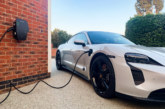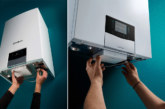
With an increasing number of electric cars on the road, should housebuilders be fitting electric charging stations to new homes?
Electric vehicles (EV) are becoming a more common sight on our roads every day. Figures from the Society of Motor Manufacturers and Traders (SMMT) show that in 2017, 47,000 plug-in cars were registered – 10,000 units more than the previous year. This level of growth looks set to continue. March 2018 saw the highest ever monthly sales of plug-in vehicles at 9,000 units and SMMT figures indicate that today there are around 146,000 plug-in vehicles in the UK.
However, even with strong market growth, one of the more significant concerns for electric vehicles remains where to charge them. For housebuilders looking to stay at the forefront of this growing market, the inclusion of EV charging points on new homes as a standard feature, or as an option, could be attractive to potential buyers.
UK based EV charge point manufacturer Rolec Services has supplied over 75,000 charging points so far and reports that the provision of EV charging points varies significantly around the UK.
Lynn Griffen, EV Commercial Sales Executive at Rolec, commented: “Residential developers’ approaches to providing EV charging points varies widely across the country. Some see the provision of EV charging points to be an additional cost which adds little value to homes, while others view it as an essential part of the electrical installation.”
Charging modes
Those that are considering installing an EV charging point should be aware that the electric vehicle industry refers to several charging ‘modes’. For residential properties this is Mode 2 and Mode 3.
“The inclusion of EV charging points on new homes as a standard feature, or as an option, could be attractive to potential buyers.”
Lynn continued: “Mode 2 provides electric vehicle charging via a 13amp standard socket. Mode 3 provides electric vehicle charging via a charging point which incorporates a communication module. This enables the EV and charging unit to communicate to optimise the charge time – and to initiate/complete the charging session. In addition, the socket rating of the charging unit may be either 16 or 32amps, as some vehicles charge at 16amps and some at 32amps.”
Electrical installation
As with any reasonably new technology, developers, planners and manufacturers need to work together to provide a solution which will meet the needs of all.
Lynn noted: “It is likely that Building Regulations will be revised to include the requirement to provide a dedicated circuit for an EV charging point. This is a great move forward and will ensure that the installations are carried out in accordance with the current edition of the IEE Wiring Regulations, BS7671 Section 722.
 “The current situation, whereby a dedicated radial circuit is not always installed, can lead to electric vehicles being plugged into ring main circuits which are already serving a number of other appliances. As the EV will draw the maximum current available (10amps on a 13amp socket) for prolonged periods of time, this can cause problems. This not only has the potential to lead to nuisance tripping, but could also lead to a potential fire risk. Residential developers should be aware of such risks and mitigate them wherever possible.
“The current situation, whereby a dedicated radial circuit is not always installed, can lead to electric vehicles being plugged into ring main circuits which are already serving a number of other appliances. As the EV will draw the maximum current available (10amps on a 13amp socket) for prolonged periods of time, this can cause problems. This not only has the potential to lead to nuisance tripping, but could also lead to a potential fire risk. Residential developers should be aware of such risks and mitigate them wherever possible.
“For little additional cost a dedicated circuit could be installed during construction, terminating at a suitable socket outlet. As it is also necessary to ensure the circuit supplying the EV charging socket has RCD protection, the configuration of the consumer unit will need considering. With this in mind, a solution would be a socket with built-in RCD protection.”
Kieron Alsop, Managing Director of Rolec EV, added: “This is why we believe our WallPod: EV Ready has its place in today’s market. Not only does it have built-in earth fault and overcurrent protection, it is IP65 rated, flame retardant and corrosion resistant. In addition to this, it can be easily upgraded to a Mode 3 charging unit by installing an upgrade kit.”








